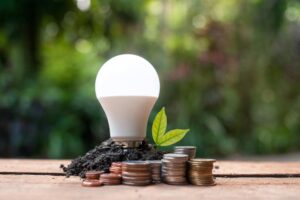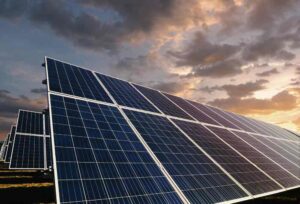The transition to solar energy has never been simpler. With advancements in technology, financial incentives, and an increasing emphasis on sustainability, solar power is now more accessible and beneficial than ever. Here, we explore the key reasons why switching to solar energy is a seamless process and how it can transform your energy consumption.
Technological Advancements in Solar Energy
Improved Solar Panel Efficiency
Modern solar panels have significantly higher efficiency rates compared to their predecessors. The latest photovoltaic (PV) technologies enable panels to convert more sunlight into electricity, ensuring that even smaller rooftops can generate substantial power. This increased efficiency means fewer panels are needed to meet your energy needs, reducing installation time and costs.
Smart Inverters and Monitoring Systems
The integration of smart inverters and advanced monitoring systems has revolutionized solar energy management. Smart inverters enhance the efficiency of energy conversion and allow for real-time monitoring of your solar system’s performance. These systems provide detailed insights into energy production, usage patterns, and potential issues, ensuring optimal performance and quick troubleshooting.
Financial Incentives and Support
Government Rebates and Tax Credits
Many governments offer substantial rebates and tax credits for solar installations. These financial incentives can cover a significant portion of the installation costs, making solar energy a more affordable option for homeowners and businesses. By taking advantage of these programs, you can reduce the upfront investment and accelerate the return on your investment.
Solar Financing Options
A variety of financing options are available to help you go solar without a large initial outlay. Solar loans, leases, and power purchase agreements (PPAs) provide flexible payment plans that suit different financial situations. These options make it easier to start saving on energy bills immediately, even if you don’t have the capital to purchase a system outright.
Environmental and Economic Benefits
Reducing Carbon Footprint
Solar energy is a clean, renewable source of power that significantly reduces your carbon footprint. By switching to solar, you contribute to decreasing greenhouse gas emissions and combating climate change. This environmentally friendly choice supports global sustainability efforts and promotes a healthier planet for future generations.
Long-term Cost Savings
Investing in solar energy offers substantial long-term financial benefits. Solar systems typically have a lifespan of 25 to 30 years, during which they generate free electricity from the sun. This leads to considerable savings on energy bills over the system’s lifetime. Additionally, with rising utility rates, generating your own power insulates you from future price increases.
Simplified Installation Process
Professional Installation Services
Reputable solar companies provide end-to-end installation services, ensuring a hassle-free experience for customers. These professionals handle everything from site assessment and system design to permitting and installation. By choosing a trusted solar provider, you can be confident in a smooth and efficient transition to solar energy.
Minimal Maintenance Requirements
Solar systems require minimal maintenance once installed. Routine cleaning and periodic inspections are usually sufficient to keep your panels operating at peak efficiency. Most solar providers offer maintenance packages or warranties, giving you peace of mind and ensuring that your investment is protected.
Solar Energy Integration with Smart Homes
Enhancing Energy Efficiency
Integrating solar energy with smart home technologies can further enhance energy efficiency. Smart thermostats, energy-efficient appliances, and automated lighting systems work in synergy with your solar panels to optimize energy consumption. This integration allows for better energy management, reduced wastage, and increased savings.
Energy Storage Solutions
Advancements in energy storage solutions, such as home batteries, enable you to store excess solar power for use during non-sunny periods or power outages. These systems provide energy independence and further reduce reliance on the grid. By incorporating energy storage, you can maximize the benefits of your solar installation and ensure a continuous power supply.
O’Brien Electrical and Solar’s Role in the Industry
O’Brien Electrical and Solar is a leader in the solar industry, providing innovative and reliable solar solutions to homes and businesses. With a commitment to quality and customer satisfaction, O’Brien Electrical and Solar has helped countless customers make the switch to solar energy, delivering substantial financial and environmental benefits.
Technological Innovations in Solar Power by O’Brien Electrical and Solar
Evolution of Solar Panels
Solar panels have come a long way since their inception. Early panels had low efficiency and high costs, but modern panels boast efficiencies of over 20% and are more affordable. The introduction of monocrystalline and polycrystalline silicon panels, along with advancements in thin-film technology, has revolutionized the industry. O’Brien Electrical and Solar stays at the forefront of these advancements, offering the latest and most efficient solar panels to its customers.
Role of Inverters in Solar Systems
Inverters are crucial components in solar systems, converting the direct current (DC) produced by solar panels into alternating current (AC) used in homes and businesses. Modern inverters, such as microinverters and string inverters, offer improved efficiency, better energy management, and enhanced system monitoring capabilities. O’Brien Electrical and Solar ensures that all their solar installations include state-of-the-art inverters, maximizing energy production and reliability.
Battery Storage and its Impact
Battery storage has transformed the solar energy landscape. By storing excess energy produced during the day, batteries allow for continuous power supply during night or cloudy days. This capability enhances energy independence and reliability, making solar power a more viable option for households and businesses. Advances in battery technology, such as lithium-ion and solid-state batteries, have improved storage capacity, efficiency, and lifespan. O’Brien Electrical and Solar provides cutting-edge battery storage solutions, ensuring that customers can fully utilize their solar energy systems.
Smart Home Integration with Solar Power
Integrating solar energy with smart home technologies has opened new possibilities for energy management. Smart thermostats, energy-efficient appliances, and automated lighting systems work seamlessly with solar power, optimizing energy use and reducing wastage. Homeowners can monitor and control their energy consumption in real time through smart apps, ensuring maximum efficiency and cost savings. O’Brien Electrical and Solar offers comprehensive solutions that integrate solar power with smart home technologies, providing customers with advanced energy management tools.
Financial Benefits of Going Solar with O’Brien Electrical and Solar
Initial Investment vs. Long-term Savings
While the initial investment in solar panels can be significant, the long-term savings are substantial. Solar panels typically pay for themselves within 5-10 years through reduced electricity bills. Over their 25-30-year lifespan, they can save homeowners tens of thousands of dollars. The declining costs of solar technology and increased efficiency further enhance the financial benefits. O’Brien Electrical and Solar helps customers understand the financial advantages of solar energy and provides detailed savings projections.
Government Incentives and Rebates
The Australian Government offer various incentives and rebates to encourage solar adoption. These can cover a significant portion of the installation costs, making solar energy more accessible. Many states and local governments offer additional incentives, further reducing the cost. O’Brien Electrical and Solar assist customers in navigating these incentives and maximizing their savings.
Solar Financing Options
There are several financing options available for those interested in going solar. Solar loans, leases, and power purchase agreements (PPAs) provide flexible payment plans, making solar energy accessible to a broader audience. These options allow homeowners to start saving on energy bills immediately, even if they don’t have the capital to purchase a system outright. Many solar companies offer zero-down financing, making it easier to switch to solar power. O’Brien Electrical and Solar offers a range of financing solutions tailored to meet the needs of different customers.
Impact on Property Value
Installing solar panels can significantly increase property value. Studies have shown that homes with solar energy systems sell faster and at higher prices than those without. Potential buyers are attracted to the prospect of lower energy bills and the environmental benefits of solar power. This added value can offset the initial installation costs and provide a good return on investment. O’Brien Electrical and Solar provides detailed information on how solar installations can enhance property value and offers expert guidance on maximizing this benefit.
Environmental Impact of Solar Energy
Reduction in Carbon Footprint
Solar energy significantly reduces carbon emissions compared to fossil fuels. By generating electricity from the sun, solar panels help decrease our reliance on coal, oil, and natural gas, which are major sources of greenhouse gases. Each kilowatt-hour (kWh) of solar power generated prevents the emission of approximately 1.5 pounds of carbon dioxide, contributing to a cleaner and healthier environment.
Comparison with Fossil Fuels
Unlike fossil fuels, which release harmful pollutants and greenhouse gases, solar energy is clean and renewable. The extraction and burning of fossil fuels cause significant environmental damage, including air and water pollution, habitat destruction, and climate change. Solar energy, on the other hand, harnesses the power of the sun without depleting natural resources or causing environmental harm.
Role in Combating Climate Change
Solar energy is a key player in the fight against climate change. By reducing greenhouse gas emissions and promoting sustainable energy practices, solar power helps mitigate the impacts of global warming. Transitioning to solar energy on a large scale can significantly reduce the carbon footprint of the energy sector, contributing to global efforts to limit temperature rise and protect the planet for future generations.
Benefits to Local Ecosystems
Solar energy also benefits local ecosystems by reducing pollution and habitat destruction. Traditional energy production methods, such as coal mining and oil drilling, can have devastating effects on wildlife and natural habitats. Solar power, however, generates clean energy without harming the environment. Moreover, solar farms can coexist with agriculture and other land uses, providing additional income sources for landowners while preserving biodiversity.
The Ease of Solar Installation with O’Brien Electrical and Solar
Steps in the Solar Installation Process
The solar installation process involves several steps, each crucial for a successful transition to solar power:
- Site Assessment: A solar provider evaluates your property to determine its suitability for solar panels. This includes analyzing roof conditions, shading, and energy needs.
- System Design: Based on the assessment, the provider designs a custom solar system tailored to your energy requirements and roof specifications.
- Permitting: The provider handles all necessary permits and approvals from local authorities and utility companies.
- Installation: Professional installers mount the panels on your roof, connect the system to your electrical grid, and set up monitoring equipment.
- Inspection and Activation: After installation, the system undergoes inspections to ensure compliance with regulations. Once approved, the system is activated, and you start generating solar power.
Choosing the Right Solar Provider
Selecting a reliable solar provider is essential for a smooth installation process and long-term satisfaction. Factors to consider include:
- Experience and Reputation: Look for providers with a proven track record and positive customer reviews.
- Quality of Products: Ensure they use high-quality, durable solar panels and equipment.
- Customer Service: Choose a provider that offers excellent customer support and comprehensive warranties.
- Pricing and Financing: Compare quotes and financing options to find the best value for your investment.
O’Brien Electrical and Solar excels in all these areas, providing top-notch products and services to ensure a seamless transition to solar energy.
Typical Timeline for Installation
The timeline for installing a solar system varies depending on several factors, including the complexity of the installation and local permitting processes. Generally, the entire process takes 1-3 months from initial consultation to system activation. O’Brien Electrical and Solar provides a detailed timeline and keeps customers informed throughout each stage of the process, ensuring a hassle-free experience.
Post-Installation Maintenance
Solar panels require minimal maintenance once installed. Regular cleaning to remove dust and debris, along with periodic inspections, is usually sufficient to ensure optimal performance. Most solar providers, including O’Brien Electrical and Solar, offer maintenance services and warranties to address any issues that may arise. Monitoring your system’s performance through apps and scheduling professional check-ups can help maintain efficiency and prolong the lifespan of your solar panels.
Solar Energy Myths Debunked
Myth: Solar Panels are Too Expensive
Many people believe that solar panels are prohibitively expensive. While the initial cost can be high, the long-term savings and available financing options make solar energy affordable for most homeowners. Government incentives, rebates, and zero-down financing plans further reduce the upfront costs, making solar power a viable option for a wide range of budgets.
Myth: Solar Power is Unreliable
Another common myth is that solar power is unreliable because it depends on sunlight. While solar panels generate more electricity on sunny days, they can still produce power on cloudy days and during winter. Moreover, battery storage solutions allow homeowners to store excess energy for use during nighttime or overcast periods, ensuring a continuous power supply.
Myth: Solar Panels Require Constant Maintenance
Some people worry that solar panels require constant maintenance and frequent repairs. In reality, solar panels are designed to be durable and low-maintenance. They typically only need periodic cleaning and occasional inspections to ensure they are operating efficiently. Most systems come with warranties that cover any potential issues, providing peace of mind to homeowners.
Myth: Solar Energy is Only for Sunny Climates
It’s a common misconception that solar energy is only effective in sunny climates. While regions with more sunlight do produce more energy, solar panels can generate electricity even in cloudy or rainy areas. Advances in solar technology have improved the efficiency of panels, making them effective in a variety of climates. Additionally, countries with less sunshine have successfully implemented solar energy on a large scale, demonstrating its viability in diverse conditions.
Future of Solar Energy
Emerging Technologies in Solar Power
The future of solar energy looks promising with several emerging technologies on the horizon. Innovations such as bifacial panels, which capture sunlight from both sides and perovskite solar cells, which offer higher efficiency and lower costs, are set to revolutionize the industry. Other advancements include solar paint, flexible solar panels, and transparent solar cells, which can be integrated into windows and other surfaces.
Predicted Trends in the Solar Industry
Several trends are expected to shape the future of the solar industry. These include the increasing adoption of solar-plus-storage systems, the growth of community solar projects, and the integration of artificial intelligence and machine learning for better energy management. Additionally, the decline in solar panel costs and the rise of solar farms will drive further adoption, making solar energy more accessible to a broader audience.
Global Impact and Adoption Rates
The global adoption of solar energy is accelerating, driven by falling costs, technological advancements, and growing environmental awareness. Countries like China, the United States, and India are leading the charge, with significant investments in solar infrastructure. As more nations commit to renewable energy targets, the global impact of solar power will continue to grow, reducing carbon emissions and promoting sustainable development.
Role of Solar Energy in Future Energy Policies
Solar energy will play a crucial role in shaping future energy policies. Governments worldwide are setting ambitious renewable energy targets and implementing policies to support the growth of solar power. These policies include subsidies, tax incentives, and regulations that promote the integration of solar energy into the grid. As the world transitions to a more sustainable energy future, solar power will be at the forefront of this transformation.
Conclusion
In conclusion, going solar has never been easier or more beneficial. Technological advancements, financial incentives, and the numerous environmental benefits make solar energy an attractive option for homeowners and businesses alike. By switching to solar power, you can reduce your carbon footprint, save on energy bills, and contribute to a sustainable future. Embrace the power of the sun and take the first step towards a cleaner, greener world with O’Brien Electrical and Solar.
FAQs
What is the lifespan of solar panels?
Solar panels typically have a lifespan of 25 to 30 years. However, their efficiency may decrease slightly over time. Most manufacturers offer warranties that guarantee a certain level of performance for 20-25 years, ensuring reliable energy production throughout their lifespan.
How much can I save with solar energy?
The amount you can save with solar energy depends on several factors, including your energy consumption, local electricity rates, and the size of your solar system. On average, homeowners can save thousands of dollars over the lifespan of their solar panels. Many solar systems pay for themselves within 5-10 years through reduced electricity bills.
Are there any downsides to solar energy?
While solar energy offers numerous benefits, there are a few downsides to consider. The initial installation cost can be high, although financing options and incentives can mitigate this. Additionally, solar panels’ efficiency can be affected by weather conditions and shading. However, advances in technology and energy storage solutions help address these challenges.
How does solar energy impact my electricity bills?
Solar energy can significantly reduce your electricity bills by generating your own power. The exact impact depends on your energy consumption and the size of your solar system. In many cases, homeowners can eliminate their electricity bills or achieve substantial savings. Excess energy can be sold back to the grid in some regions, further offsetting costs.
Can I go off-grid with solar energy?
Going off-grid with solar energy is possible but requires careful planning and a robust energy storage system. By combining solar panels with battery storage, you can store excess energy for use during non-sunny periods. However, going off-grid may require a larger investment in storage and backup systems to ensure a reliable power supply.






